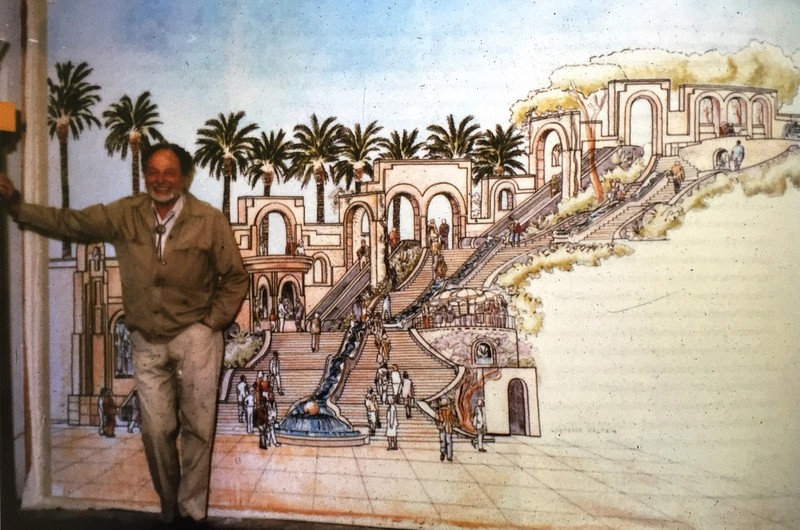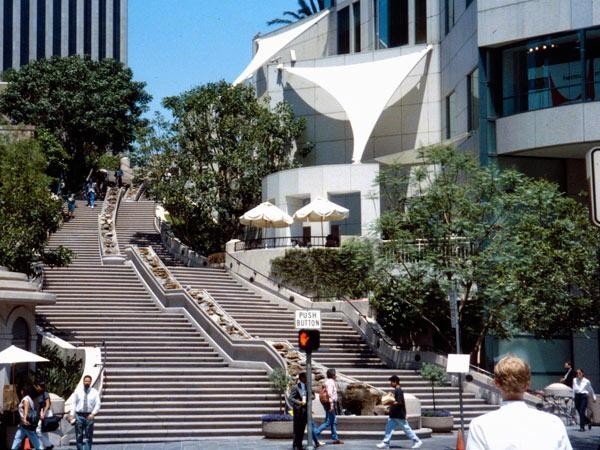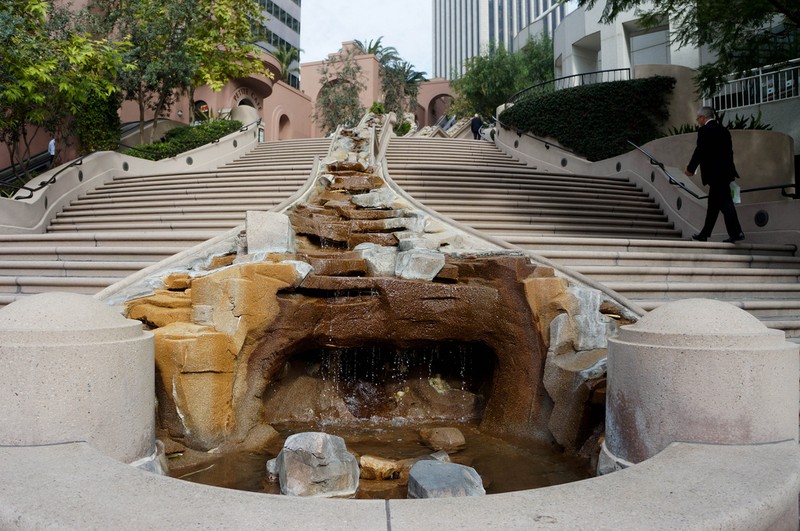Bunker Hill Steps
Introduction
Text-to-speech Audio
Images
Lawrence Halpin with a drawing of the Steps.

A shot of the steps from across the street.

A shot of the fountain at the bottom of the Steps.

Backstory and Context
Text-to-speech Audio
When the height limit of buildings in Los Angeles was finally raised, developers built some of the tallest skyscrapers in the region to take advantage of the area's existing dense zoning. The project is the longest redevelopment project in Los Angeles history. The majority of the skyscrapers on Bunker Hill were built in the 1980s, with a new skyscraper or two being finished nearly every year. However, the momentum died down in the 1990s, shortly after the fifty-two story Two California Plaza was finished.
Prior to this, Bunker Hill used to slope gently down to about Sixth St. The impressive State Normal School, which would later evolve into UCLA, was built in 1881 where the LA Central Library sits today. In 1926, after the school had been demolished, the Central Library was constructed. In 1931, The Southern California Edison Building, which is now One Bunker Hill, was built on the NW corner of Grand Avenue and Hope Place, directly to the east of the Engstrom Apartments.
The original Bunker Steps were constructed at around the same time as Central Library, as they formed part of the retaining wall necessary to keep Bunker Hill in place after the southern slope was cut away. The steps also maintained Bunker Hill residents' access to the business district. Originally there was also a plan to build a pedestrian bridge from an upper part of Central Library to Bunker Hill, but this was never realized.
The site of the old Bunker Hill steps disappeared in 1989 underneath the giant 73-story Library Tower (now U.S. Bank Tower), the tallest building in California. A sliver of land was left open between the back of the 444 South Flower Building and the west side of Library Tower to accommodate the new Bunker Hill Steps which were completed in 1987 by architects I.M. Pei & Partners and developer Robert Maguire.
The grand stairway and water garden was designed by Halprin to link downtown Los Angeles to the newly developed Bunker Hill section of the city. Postmodern in style and reminiscent of Rome’s Spanish Steps, the steps are choreographed as an urban experience similar to a city street, complete with terraced landings, retail shops, and outdoor cafes with a range of activities for relaxing, dining, or shopping.
Sources
The Bunker Hill Steps. Southland Architecture. Accessed July 29, 2017. http://www.southlandarchitecture.com/Building/3628/The-Bunker-Hill-Steps.php.
Bunker Hill Steps. TCLF. Accessed July 29, 2017. https://tclf.org/landscapes/bunker-hill-steps.
Climb to the top of Bunker Hill Monument. Free Tours by Food. Accessed July 29, 2017. http://www.freetoursbyfoot.com/climb-top-bunker-hill-monument/.
Ground Level: Lawrence Halprin's Bunker Hill Steps. LA Times Blogs. April 20, 2011. Accessed July 29, 2017. http://latimesblogs.latimes.com/culturemonster/2011/04/ground-level-lawrence-halprins-bunker-hill-steps-.html.
